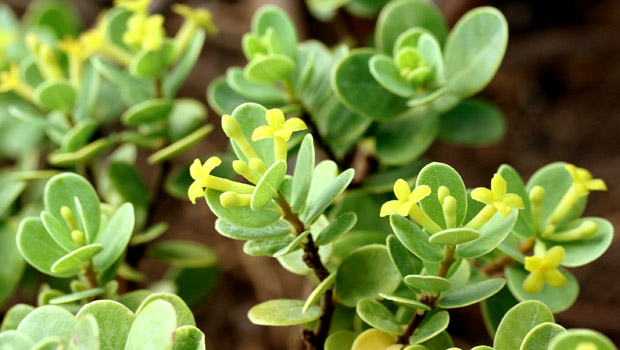‘Ākia

The littoral fringe ecosystem is as much a part of Hawaii’s shorelines as our popular beaches and reefs. The Aquarium wants to emphasize the important link between land and sea by drawing attention to this often overlooked native environment. Healthy shores and healthy reefs are a part of Hawaii’s heritage. Just as plants of the uplands protect the watershed with a cloak of vegetation, coastal plants secure the dunes and slow shoreline erosion. And, many coastal plants serve traditional uses and hold cultural significance in Hawai‘i and throughout the Pacific. Some plants, like the naupaka-kahakai (Scaevola sericea) are indigenous – found naturally in Hawai‘i as well as elsewhere. Others, like the ‘ohai (Sesbania tomentosa) are endemic – unique species found only in Hawai‘i. While others, like the kukui (Aleurites moluccana), were brought on canoes by early Polynesian settlers. These plants aren’t considered native, they are very culturally important species, that allowed early settlers to survive on remote islands with unfamiliar vegetation.
Sadly, human activities have altered or destroyed the natural profile and vegetation along much of Hawaii’s shores. Some shoreline developments and homes are built on the shore rather than behind it; landscaping often uses exotic ornamentals rather than adapted native plants. On less developed shorelines, recreational activities like, camping, and even hiking on the dunes, break the protective cover of vegetation causing dunes to erode, and allowing aggressive weeds crowd out remaining native species.
Waikīkī once had a different profile and vegetation than we see today. The Waikīkī Aquarium’s Coastal Gardens provide a glimpse of the diversity of this important native habitat, fascinating plants and their adaptations. The Aquarium has expanded its plantings and helped restore a bit of Waikiki’s natural lei of native coastal plants. More than twenty native plant species are currently established in the Aquarium’s gardens.
The endemic plant ‘ākia, is a sprawling shrub that is adapted to dry, windy, coastal cliffs and shorelines. ‘Ākia, though listed as a threatened species, has become a popular ornamental plant used in gardens around Hawai‘i, and at Waikīkī Aquarium. Traditionally, the bark from the roots and stems of ‘ākia were crushed and then thrown into small tide pools. Within a few minutes, stupefied fish floated to the surface and were harvested. The poison would dissipate, either through dilution or through time, and the remaining tidepool fish would recover from the temporary stunning.
Quick Facts
Hawaiian name
‘Ākia
Scientific name
Wikstoemia uva-ursi
Distribution
Endemic to the Hawaiian Islands, found from Kaua‘i to Maui
Support the Aquarium
Contact Us
Honolulu, HI 96815
(808) 923-9741
Search
- Already a Volunteer?
- Click Here To Sign In


 Donate
Donate
